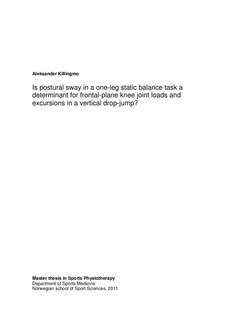| dc.description.abstract | Background: Team handball and soccer world have a high incidence of anterior
cruciate ligament (ACL) injuries. This injury has severe consequences such as long term
rehabilitation, sport disability and osteoarthritis. The mechanism of injury is still
debated, and some, but not all risk factors are known. Preventive training programs
have shown to reduce the incidence of ACL injury; many of these programs include
balance training, yet it is not known whether poor balance is a risk factor for ACL
injury. A comprehensive knowledge of the risk to sustain an ACL injury would increase
the ability to identify players at risk and to improve existing preventive training
regimes. Frontal plane knee joint kinetics and kinematics of a vertical drop-jump (VDJ)
have in a previous study been used to identify athletes at risk. Purpose: This study is
part of an extensive cohort study that aims to identify risk factors of ACL injuries in
female team handball and soccer players. The objective of this study is to explore the
possible association between postural sway (PS), of one-leg static stance and knee joint
kinetic and kinematics of a VDJ by 3D motion analysis? Study design: Cross sectional
study. Methods: Out of 184 female team handball players and 187 female soccer
players from the top divisions in Norway that attended the VDJ and one-leg static
balance test, 151 team handball results and 156 soccer results were valid and analyzed.
The one-leg static balance was recorded as mediolateral and anterioposterior velocity
(m/sec), total distance (mm) and 95% ellipse area (mm2) of PS, while the frontal plane
knee joint kinetics and kinematics was measured as frontal plane projection angle (°),
valgus angle (°) and valgus moment (Nm/kg). Results: There were only four
statistically significant associations of PS measures and knee joint kinetics and
kinematics out of 48 possible. The significant associations were between frontal plane
projection angle and mediolateral sway, total distance and 95% ellipse area, and
between valgus angle and 95% confidence area. The R2 coefficients for the statistically
significant associations were small. Conclusion: The results of this study did not reveal
any consistent association between PS in one-leg static balance and FPPA, valgus angle
and valgus moments in VDJ. Considering the limitations in this study, a possible
association between postural sway and knee joint kinetic and kinematics should not be
dismissed. | no_NO |
